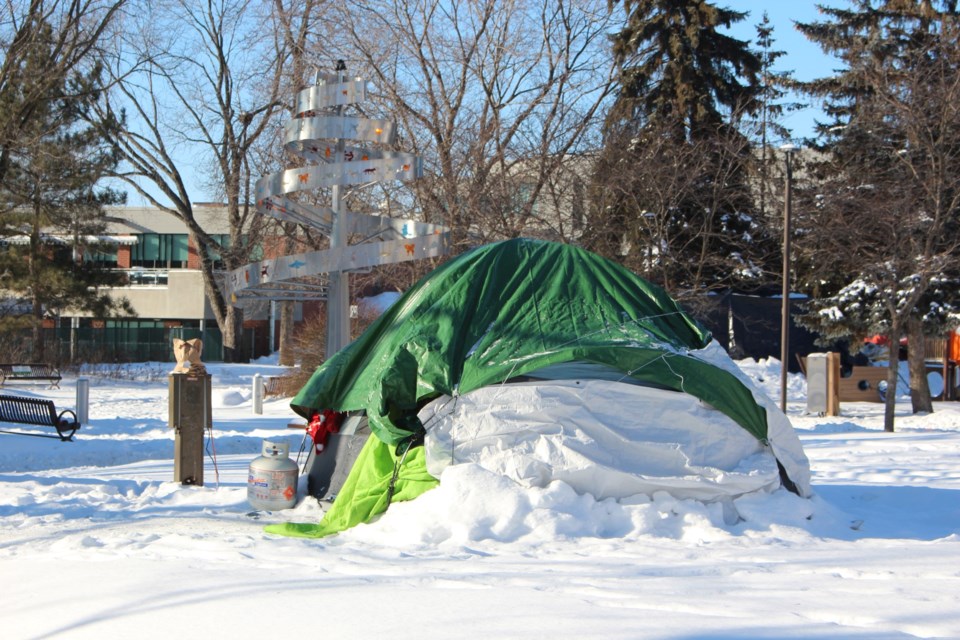Greater Sudbury city council was unanimous during Tuesday night's meeting in supporting the Roadmap to End Homelessness by 2030 plan drafted by city staff.
The plan maps a proposed path toward “functional zero” homelessness by 2030, which is described by city Children and Social Services director Tyler Campbell as a homeless community of three people or fewer, with homelessness “a rare, brief and non-recurring” thing.
Tonight’s unanimous decision doesn’t spark any immediate significant action, but signals city council’s intent to adopt the Roadmap to End Homelessness by 2030 as the city’s official plan.
It also directs staff to begin drafting relevant business cases for consideration as part of the 2025 budget process slated to take place later this year.
Although the plan’s $350-million price tag is significant, Mayor Paul Lefebvre clarified to Sudbury.com following Tuesday’s meeting that it’ll be spread between three levels of government, and not necessarily on a 1/3 basis.
“What usually happens is, the feds pay for the capital, the province pays for the operation, and we’re there to support and administer it for everybody,” he said. “We’ll be paying for the wrap-around services ... hopefully with the province.”
This has not been the case with the Lorraine Street transitional housing complex currently under construction (the federal government pledged $7.4 million and the province has yet to step in to help), but Lefebvre said he has continued to advocate for funding every chance he gets.
The city is currently funding an Assertive Community Treatment Team of medical professionals, who work with people experiencing chronic homelessness to help get them into permanent community housing. They’re slated to shift from temporary locations into the Lorraine Street building as soon as it’s open. These jobs fall under provincial jurisdiction.
“Any time I can, I’m saying (to the province), we have a program that’s working,” Lefebvre said of the team. “It’s alleviating the hospital, alleviating our justice system, because we’re allowing people to get out of homelessness and they’re not falling back in.”
The main costs associated with the Roadmap to End Homelessness by 2030 plan includes:
- $322 million in capital and start-up costs
- $13.6 million annually in operating costs
- $11 million annually in additional rent supplements
It calls for various preventative measures, investments in housing and access to transitional units, extended shelter hours, investments in housing and various measures to fill service gaps.
Ward 5 Coun. Mike Parent requested the Roadmap to End Homelessness by 2030 plan in a motion he tabled with city council last year.
During tonight’s meeting, Parent added a personal angle to his commitment to the cause, noting that between 1996 to 2005, he worked as a paramedic and heard various stories from the city’s homeless community.
“I realized that every person has a story, and what brought them to becoming homeless was almost always due to a series of calamitous events,” he said.
Several years ago, Parent said that personal circumstances brought him “to a very bad place.”
“Eventually, I began making decisions that only aggravated my situation,” he said, adding that he was going down “a slippery slope.”
“Things like out-patient programs and other similar programs did not help me, and to be honest, some of these may have made things worse for me.”
An acquaintance intervened, and benefits through his employer allowed him the help he needed, which he said proved to be “a turning point” in his life.
Through this experience, Parent said he’s of the belief that with proper professional help and structure, similar turning points can be afforded to members of the city’s homeless community.
Although the $350-million cost sounds “astronomical,” Parent argued that a great deal is already being spent by governments on homelessness, both directly and indirectly, and yet homelessness is on the rise.
Last year, city council received a report noting that 165 community organizations were delivering 723 programs for vulnerable residents within Greater Sudbury.
Campbell’s presentation points to affordable housing as a significant contributor to homelessness, which is in short supply within a rental market carrying a vacancy rate of less than one per cent.
“We are regularly seeing bachelor and studio apartments going for $1,100 or more,” he said, clarifying that Ontario Works recipients get $390 per month for shelter and Ontario Disability Support Program recipients receive $556. The average market rent for one bedroom in Greater Sudbury was $1,043 in October 2023, according to the Canada Mortgage and Housing Corporation.
There are currently 8,500 people in Greater Sudbury enrolled in these programs who have only $390 to $556 toward shelter, he said.
Following Tuesday’s meeting, Lefebvre told Sudbury.com that the next big step will be getting more municipal land shovel-ready for affordable housing, ramping up work they’ve already been doing.
“When the door opens with federal funding, we’re preparing for that,” he said. “I’m anticipating that as soon as those programs open we’ll be deliberating this at council as to what we apply for.”
Between now and 2025 budget deliberations in early December, he added, “there’s a lot of work to be done.”
All 13 members of Greater Sudbury city council were present for Tuesday night’s unanimous show of support.
Tyler Clarke covers city hall and political affairs for Sudbury.com.
